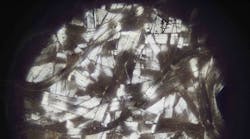Biomimetic moth silk fibers block sunlight and could transmit images
Columbia University Engineering (New York, NY) researchers have discovered that fibers produced by the caterpillars of a wild silk moth, the Madagascar comet moth (Argema mittrei), are far superior in terms of brilliance and cooling ability. Not only do the comet moth's silk fibers have outstanding thermal-deflecting (cooling) properties, they also have exceptional capabilities for transmitting light signals and images.
RELATED ARTICLE: Silk-based implantable optics boost tissue imaging
Led by Nanfang Yu, associate professor of applied physics, the team characterized the optical properties associated with one-dimensional nanostructures they found in comet moth cocoon fibers. They were so fascinated by the unusual properties of these fibers that they developed a technique to spin artificial fibers that mimic the nanostructures and optical properties of the natural fibers. The study of these biomimetic moth structures is published in Light: Science & Applications.
"The comet moth fibers are the best natural fibrous material to block sunlight we've ever seen. Synthesizing fibers possessing similar optical properties could have important implications for the synthetic fiber industry," said Yu, an expert in nanophotonics. "Another amazing property of these fibers is that they can guide light signals or even transport simple images from one end to the other end of the fiber. This means we might be able to use them as a biocompatible and bioresorbable material for optical signal and image transport in biomedical applications."
While individual fibers produced by our domesticated silkworms look like solid, transparent cylinders under an optical microscope, the individual thread spun by the comet moth caterpillars has a highly metallic sheen. The comet moth fibers contain a high density of nanoscale filamentary air voids that run along the fibers and cause strong specular (mirror-like) reflection of light. In addition, the high reflectivity of comet moth fibers extends well beyond the visible range into the infrared spectrum--invisible to the human eye but containing about half of the solar power. This, together with the fibers’ ability to absorb ultraviolet (UV) light, makes them ideal for blocking sunlight, which contains UV, visible, and infrared components.
The ability of comet moth fibers to guide light is an effect known as transverse Anderson localization, and is a result of the filamentary air voids along the fibers: the air voids cause strong optical scattering in the fiber cross-section, providing sideways confinement of light, but presenting no impediment for light propagation along the fibers.
"This form of light guiding--confining light to propagate within the interior of a strand of material with no sideways light leakage--is very different from the one utilized in light transmission through undersea fiber-optic cables, where light confinement is provided by reflection at the boundary between a fiber core and a cladding layer," said Norman Shi, lead author of the paper and a PhD student recently graduated from Yu's lab, said. "This is the first time transverse Anderson localization has been discovered in a natural materials system. Our finding opens up potential applications in light guiding, image transport, and light focusing where biocompatibility is required."
Once Yu's team had characterized the comet moth fibers, they then set to inventing novel fiber pulling methods that emulate the fiber spinning mechanism of the comet moth caterpillar to create fibers embedded with a high density of particulate or filamentary voids. The researchers achieved a density of voids several times higher than that found in the natural fibers: a single bioinspired fiber is able to reflect 93% of sunlight. They produced these bioinspired fibers using two materials: a natural material (regenerated silk) and a synthetic polymer (polyvinylidene difluoride). While the former is suitable for applications requiring biocompatibility, the latter is suitable for high-throughput production.
In addition, ultra-thin apparel made of the "porous" fibers would promote cooling through a combination of sweat evaporation, air flow between the microenvironment of the human body and the exterior, and radiation of body heat to the external environment.
The Madagascar comet moth is one of the largest in the world, with cocoons spanning 6 to 10 cm in length. These extraordinary fibers, whose filamentary air voids could be the result of natural selection to prevent overheating, were brought to Yu's attention by Catherine Craig, director of the NGO Conservation through Poverty Alleviation, International. CPALI works with rural farmers in Madagascar to develop sustainable livelihoods that support both people and ecosystems by cultivating and marketing native resources, one product being the fibers produced by the caterpillars of the comet moth.
Yu is currently working on increasing the throughput of producing such bioinspired nanostructured fibers. His lab wants to achieve this with minimal modifications to the common practice of industrial fiber pulling.
SOURCE: Columbia University in the City of New York; http://engineering.columbia.edu/news/comet-moth-fabric
About the Author

Gail Overton
Senior Editor (2004-2020)
Gail has more than 30 years of engineering, marketing, product management, and editorial experience in the photonics and optical communications industry. Before joining the staff at Laser Focus World in 2004, she held many product management and product marketing roles in the fiber-optics industry, most notably at Hughes (El Segundo, CA), GTE Labs (Waltham, MA), Corning (Corning, NY), Photon Kinetics (Beaverton, OR), and Newport Corporation (Irvine, CA). During her marketing career, Gail published articles in WDM Solutions and Sensors magazine and traveled internationally to conduct product and sales training. Gail received her BS degree in physics, with an emphasis in optics, from San Diego State University in San Diego, CA in May 1986.
